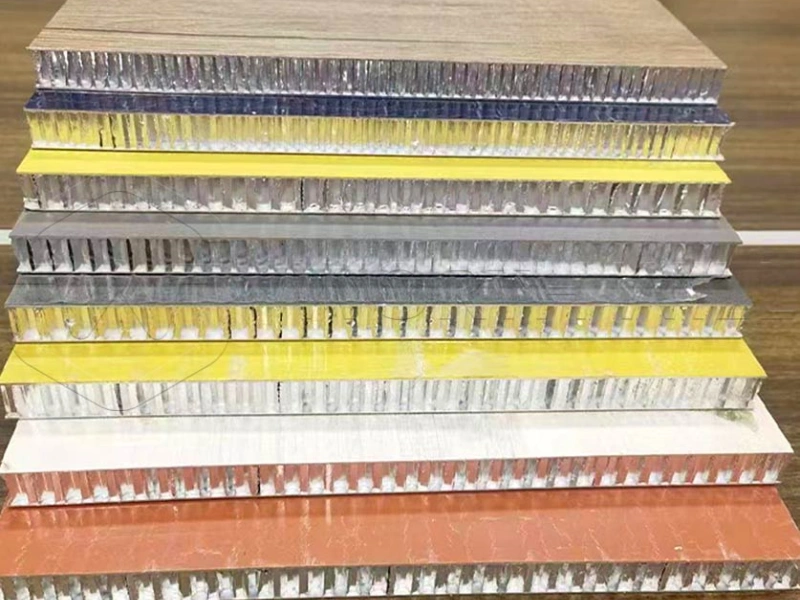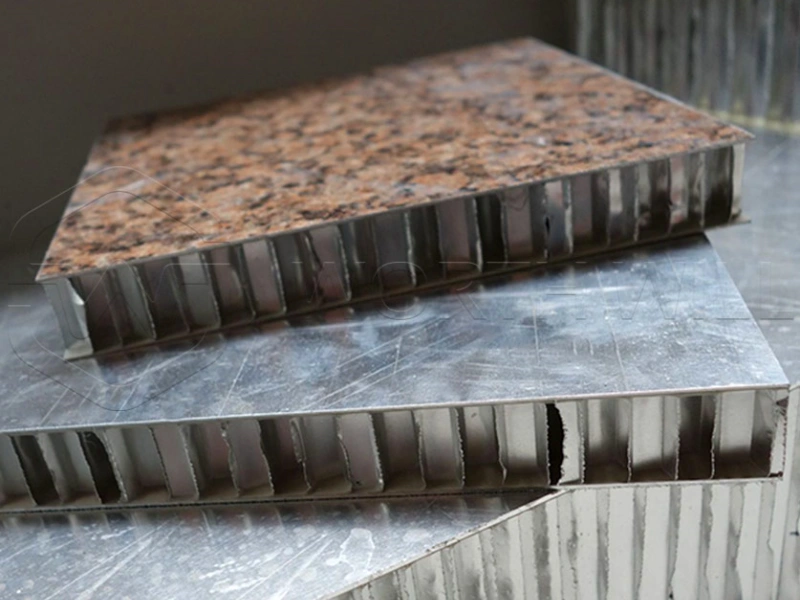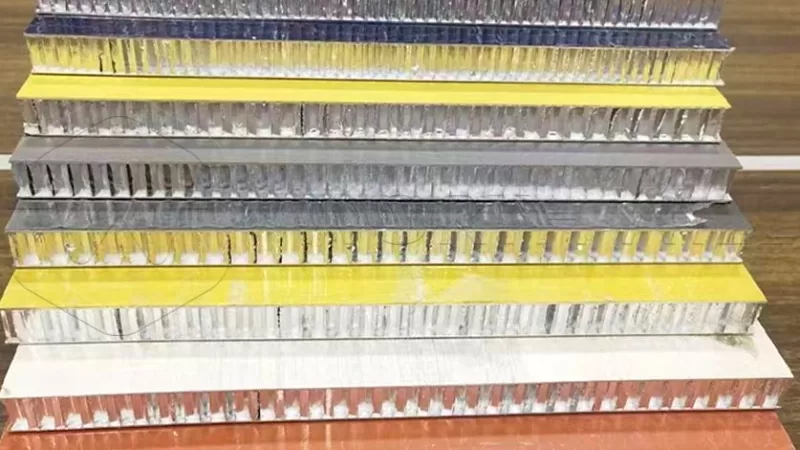In the evolving landscape of modern construction and advanced manufacturing, aluminum honeycomb panels have emerged as a leading material choice. Among the most sought-after dimensions is the 4×8 (4 feet by 8 feet) size, a standard that balances transportability with generous coverage.





Specification
Aluminum honeycomb panels are strong, lightweight, and versatile building materials widely used in construction, transport, and design industries. The standard size “4×8” refers to 4 feet by 8 feet (1220mm x 2440mm), which is the most commonly requested panel dimension.
- Panel Size: 4×8 ft (1220mm x 2440mm)
- Thickness: 6mm – 30mm
- Core Thickness: 5mm – 25mm
- Skin Thickness: 0.4mm – 1.5mm
- Alloy Types: 3003, 5052, 5005, 1100
- Surface Finish: PVDF coating, PE coating, anodized, mirror, or brushed
Classification
Aluminum honeycomb panels are classified by:
✅ By Application
- Interior wall cladding
- Exterior curtain walls
- Ceiling panels
- Elevator panels
- Furniture and cabinets
✅ By Core Type
- Aluminum honeycomb core
- Nomex honeycomb core
- Paper honeycomb (less common)
✅ By Surface Finish
- Painted aluminum (PE or PVDF)
- Brushed or mirror aluminum
- Stone or wood veneer laminates
Alloy
The most common aluminum alloys for honeycomb panels include:
- 3003-H14: Good formability and corrosion resistance
- 5052-H32: Higher strength and marine-grade performance
- 5005: Superior anodizing quality
- 1100: Pure aluminum with high ductility, mainly used for internal walls
These alloys determine the panel’s weight, strength, and corrosion resistance.
What Are Aluminum Honeycomb Panels?
An aluminum honeycomb panel is a sophisticated composite structure designed to be both incredibly rigid and remarkably lightweight. It typically consists of two thin aluminum “skins” or face sheets bonded to a thicker core made of hexagonal aluminum cells, resembling a honeycomb. This ingenious construction allows the panel to distribute forces efficiently across its structure, enabling it to withstand significant loads while keeping its overall mass to a minimum. The result is a panel that is not only strong and durable but also inherently stable and flat.
Why Choose Aluminum Honeycomb Panels?
The advantages of utilizing aluminum honeycomb panels are extensive, making them a preferred material in numerous demanding applications.
- Exceptional Strength-to-Weight Ratio: This is the hallmark benefit. Despite being incredibly lightweight, these panels offer remarkable stiffness and rigidity, often outperforming much heavier traditional materials.
- Superior Flatness and Stability: The honeycomb core provides excellent dimensional stability, resulting in panels with outstanding flatness, crucial for aesthetic applications and precision requirements.
- Fire Resistance: Aluminum is a non-combustible material, and the air trapped within the honeycomb cells further contributes to the panel’s fire-resistant properties.
- Corrosion Resistance: The inherent properties of aluminum make these panels highly resistant to rust and corrosion, even in harsh or humid environments.
- Thermal and Acoustic Insulation: The isolated air pockets within the honeycomb structure offer effective thermal insulation and contribute to sound dampening, enhancing energy efficiency and comfort.
- Durability and Longevity: Aluminum honeycomb panels are resistant to moisture, chemicals, and UV radiation, ensuring a long service life with minimal maintenance.
- Versatility: These panels can be easily cut, formed, and finished, allowing for a wide range of custom designs and ease of installation.
- Eco-Friendly: Aluminum is 100% recyclable without any loss of quality, making these panels a sustainable and environmentally conscious choice for any project.
Specification: Factors Affecting Aluminum Honeycomb Panels 4×8 Price
When sourcing aluminum honeycomb panels 4×8, several key specifications directly influence the final cost. Understanding these elements is essential for making an informed purchasing decision.
Panel Thickness
The overall thickness of the aluminum honeycomb panel directly impacts its stiffness and strength, and consequently, its 4×8 price. Common thicknesses for these panels can range from as thin as 6mm (approx. 1/4 inch) to 25mm (approx. 1 inch) or even 50mm (approx. 2 inches) and beyond for specialized applications. Thicker panels naturally require more material and manufacturing effort, leading to a higher price.
Aluminum Skin Thickness
The thickness of the top and bottom aluminum skins (or face sheets) is another critical factor. Typically ranging from 0.5mm to 3.0mm, thicker skins contribute to higher impact resistance, greater structural integrity, and increased cost. For a standard 4×8 aluminum honeycomb panel, common skin thicknesses are often around 0.8mm or 1.0mm.
Core Cell Size
The hexagonal cells of the honeycomb core come in various sizes (cell diameter), affecting the panel’s mechanical properties. Smaller cell sizes (e.g., 3.2mm, 6.35mm) generally provide higher compressive strength and shear strength, making the panel more rigid and suitable for high-load applications. Panels with smaller cell sizes can be more expensive due to the increased material density and manufacturing precision.
Surface Finishes
The surface finish profoundly impacts both the aesthetic appeal and the protective qualities of the panel, directly influencing the aluminum honeycomb panels 4×8 price. Common finishes include:
- PVDF (Polyvinylidene Fluoride) Coating: Highly durable, excellent color retention, and superior UV resistance, making it ideal for exterior architectural applications where weathering is a concern. PVDF coatings typically represent a higher cost.
- PE (Polyester) Coating: More economical, good for interior use, and offers a wide range of colors.
- Anodized Finish: Creates a tough, corrosion-resistant, and aesthetically pleasing surface through an electrochemical process. This adds to the cost but enhances durability.
- Powder Coating: Provides a robust and decorative finish with a wide array of color options, often used for interior and semi-exterior applications.
Panel Dimensions (4×8)
The 4×8 (4 feet by 8 feet or approximately 1220mm x 2440mm) dimension is a standard sheet size in the industry. Opting for a standard size like this can often be more cost-effective than custom dimensions, as manufacturers can optimize production processes and minimize material waste.
Classification: Tailoring Panels to Applications
Aluminum honeycomb panels are classified primarily by their intended application and specific material properties, which in turn affect their 4×8 price.
- Exterior Wall Cladding Panels: Designed to withstand outdoor elements, these panels often feature robust PVDF coatings, thicker skins, and specific aluminum alloys for enhanced durability, weather resistance, and fire safety in building facades.
- Interior Decorative Panels: Focus on aesthetics, flatness, and sometimes acoustic properties. They might use PE coatings or decorative laminates and are typically thinner and lighter.
- Ceiling Panels: Lightweight and easy to install, often incorporating lighting or acoustic features.
- Cleanroom Panels: Manufactured to meet strict cleanliness, flatness, and non-shedding requirements for controlled environments in industries like pharmaceuticals and electronics.
- Flooring Panels: Engineered for high load-bearing capacity and anti-slip properties, often found in transportation or industrial settings.
Alloy: The Foundation of Panel Performance
The choice of aluminum alloy for both the skins and the honeycomb core is a critical factor influencing the panel’s mechanical properties, corrosion resistance, and overall aluminum honeycomb panels 4×8 price. Reputable aluminum honeycomb panel suppliers will always specify the alloys used.
Common Alloys for Aluminum Skins
- 3003 Aluminum Alloy: This is one of the most widely used alloys for aluminum honeycomb panel skins. It contains manganese, which improves its strength and corrosion resistance compared to pure aluminum. It offers good formability and weldability, making it versatile and often a cost-effective choice for general applications.
- 5005 Aluminum Alloy: A higher-strength alloy containing magnesium, offering superior corrosion resistance, especially in marine and industrial environments. It’s often chosen for exterior architectural applications where enhanced durability against saltwater or pollution is required, typically at a slightly higher cost.
- 5052 Aluminum Alloy: Known for its excellent strength-to-weight ratio and superb corrosion resistance, 5052 is also a common choice, particularly when higher strength and better resistance to specific chemicals are needed, representing a more premium option.
Common Alloys for Honeycomb Core
- 3003 Aluminum Alloy: Most aluminum honeycomb cores are made from 3003 alloy due to its good strength, excellent formability (essential for creating the honeycomb structure), and good corrosion resistance, which is vital for the core’s longevity within the panel.
The selection of the appropriate aluminum alloy ensures the panel delivers the desired performance characteristics for its intended use, whether it’s for lightweight aerospace components or durable architectural facades. Higher grade alloys will generally result in a higher aluminum honeycomb panels 4×8 price.
Understanding Aluminum Honeycomb Panels 4×8 Price
It’s important to note that the aluminum honeycomb panels 4×8 price is not static. It is influenced by several dynamic factors:
- Raw Material Market: The global price of aluminum on commodity exchanges significantly impacts the cost of raw materials.
- Supplier and Manufacturer: Prices can vary between different aluminum honeycomb panel suppliers, depending on their manufacturing processes, overheads, and scale of operation. Buying directly from a manufacturer might offer different pricing than through a distributor.
- Order Quantity: As with most industrial materials, larger bulk orders often qualify for significant discounts per panel compared to smaller, individual purchases.
- Shipping and Logistics: Freight costs, especially for international orders or large volumes, can be a substantial part of the final price.
Given these variables, it’s impossible to provide an exact current aluminum honeycomb panels 4×8 price. For accurate figures, you should always request a detailed quote from reputable aluminum honeycomb panel suppliers based on your specific requirements.
Applications of Aluminum Honeycomb Panels (4×8 size and beyond)
The versatility and superior properties of aluminum honeycomb panels have led to their widespread adoption across diverse industries. The 4×8 price makes this standard size attractive for many of these applications:
- Architecture and Construction:
- Exterior and interior wall cladding for commercial buildings, often utilizing 4×8 panels for efficient coverage.
- Ceiling panels and suspended ceiling systems due to their lightweight nature.
- Decorative partitions and acoustic panels in offices and public spaces.
- Column covers and specialized architectural features.
- Cleanroom walls and doors requiring high flatness and non-shedding properties.
- Transportation:
- Flooring, walls, and interior components in aircraft (aerospace industry) where lightweight is paramount.
- Decking, bulkheads, and interior panels in ships and boats (marine industry) for corrosion resistance.
- Train and subway car components, including doors, floors, and ceilings.
- Truck bodies and trailer panels, reducing vehicle weight and improving fuel efficiency.
- Industrial Applications:
- Machine covers and enclosures requiring rigidity and reduced weight.
- Work platforms and lightweight structural components.
- Heat exchangers and air flow straighteners due to efficient thermal properties.
- Clean benches and laboratory equipment.
- Furniture and Interior Design:
- Lightweight tables, doors, and cabinet panels.
- Display boards and exhibition stands.
- High-end furniture components.
- Specialty Applications:
- Elevator car panels.
- Substrates for solar panels.
- Signage and billboards requiring large, flat, and durable surfaces.
How to Get the Best Aluminum Honeycomb Panels 4×8 Price
To secure the most competitive aluminum honeycomb panels 4×8 price for your project, consider these tips:
- Clearly Define Specifications: Be precise about the required panel thickness, skin thickness, core cell size, aluminum alloy, and surface finish. This prevents over-specifying and paying for properties you don’t need.
- Request Multiple Quotes: Contact several reputable aluminum honeycomb panel suppliers to compare their pricing, lead times, and terms.
- Consider Bulk Purchasing: If your project allows, ordering a larger quantity of 4×8 panels can often lead to significant per-panel discounts.
- Factor in Total Cost: Always include shipping costs, potential cutting or fabrication charges, and lead times when comparing quotes.
- Inquire About Quality and Certifications: Ensure the supplier provides materials that meet relevant industry standards (e.g., ISO certifications) to guarantee product quality and performance.
Conclusion
Aluminum honeycomb panels represent a pinnacle of material engineering, offering an unmatched combination of lightweight design, high strength, superior flatness, and aesthetic appeal. Their broad application across construction, transportation, and various industrial sectors underscores their versatility and exceptional performance. Understanding the intricate factors that influence aluminum honeycomb panels 4×8 price—from the specific aluminum alloy and thickness to market conditions and supplier capabilities—empowers you to make intelligent purchasing decisions. By conducting thorough research and engaging with reputable aluminum honeycomb panel suppliers, you can confidently select the right panels to achieve durable, efficient, and visually stunning results for your next project.
